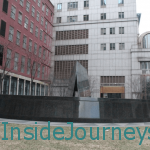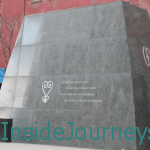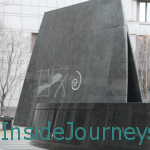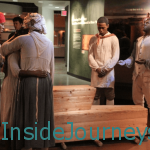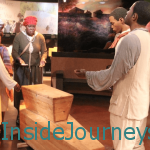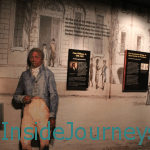Before the American Revolution, New York had more enslaved Africans – its most valuable commodity – than any other colony in the North. There were also free Africans, some descended from those freed by the Dutch West India Company. Men cleared farmland, filled swamps, and built structures and roads like Broadway and The Wall (today’s Wall Street). Women sewed, cooked, harvested, and cared for owners’ children as well as their own. From an early age, children carried water and firewood. The work was hard and death rates for Africans were disproportionately high. – National Park Service / US Department of the Interior
Between 1690-1794, approximately 15,000 enslaved and free Africans were buried in a 6.6-acre plot in Lower Manhattan near what is now Duane and Elk Streets. The area was identified on maps of the time as the Negros Burial Ground.
In 1991, an archeological team that was field-testing a construction site in Lower Manhattan (a requirement on any project which uses public funds that may have the potential to impact historic resources) made a surprising discovery – skeletal remains 24 feet below ground.
They stopped excavation when it was determined that the remains were from the Negros Burial Ground. In all 419 bodies of men, women and children were unearthed. Bone fragments and other items uncovered at the site were sent to Howard University for examination.
The remains held a compelling narrative about the life of New York City’s African population. It showed that many were malnourished, suffered from delayed bone development and recurrent illnesses. Nine percent of those buried at the site were children 2 years of age and younger.
Many of the dead were adorned with beads, which were culturally significant, and shells that were believed to “enclose the soul’s immortal presence.” Some had their eyes covered with coins.
At first, the government wanted to exhume and preserve the remains and continue construction of the 34-story Ted Weiss federal building but the community was outraged. Months of protests led to an agreement. A third of an acre of the site was set aside for a memorial.
In 1993, the African Burial Ground was designated a National Historic Landmark, and a National Monument in 2006. In 2003, the remains were reinterred in seven raised mounds at the site.
A memorial, which was designed by Rodney Léon was completed in 2007. It features a sunken Libation Court, a gathering space for cultural ceremonies, and is surrounded by a Circle of the Diaspora that is inscribed with signs, symbols, and images from the African Diaspora.
There’s also an Ancestral Chamber that provides sacred space for contemplation, and a Wall of Remembrance that describes events that contributed to the creation of the African Burial Ground. The location where the remains were reburied are marked by Ancestral Pillars.

A visitor center, which is located on the ground floor of the Weiss Building, features a permanent exhibition which tells the story of the lives of Africans in New York through photos, scrapbooks and installations. Life-size and lifelike sculptures of men and women gathered around a coffin is the centerpiece of the exhibition.
African Burial Ground National Memorial Particulars
The African Burial Ground Memorial site, which is at the corner of Duane and Elk Streets, is closed during the winter. However, the African Burial Ground Visitor Center, located around at 290 Broadway at Duane Street is open Tuesday-Saturday 10:00 a.m. to 4:00 p.m. Admission is free, but donations are accepted.
Further Reading:
Gotham: A History of New York City to 1898 [simpleazon-image align=”center” asin=”0195140494″ locale=”us” height=”160″ src=”http://ecx.images-amazon.com/images/I/51A0v0-vafL._SL160_.jpg” width=”108″]
Linking up this week with Nancie’s Travel Photo Thursday at Budget Travelers Sandbox.

